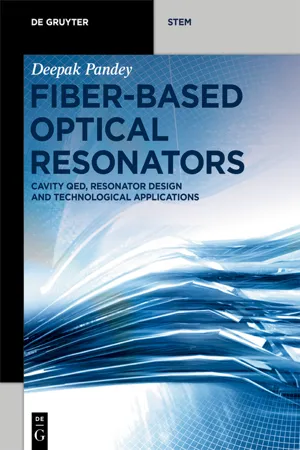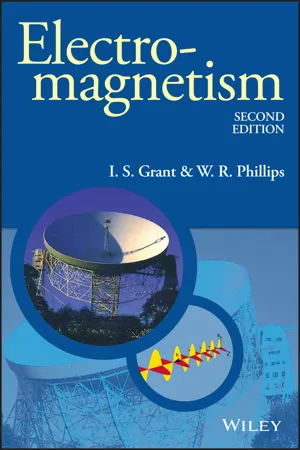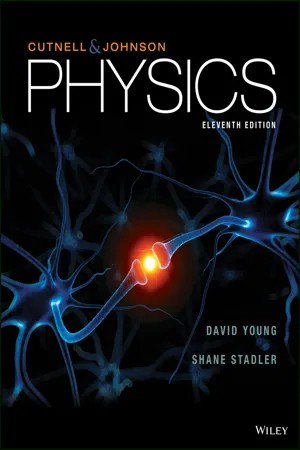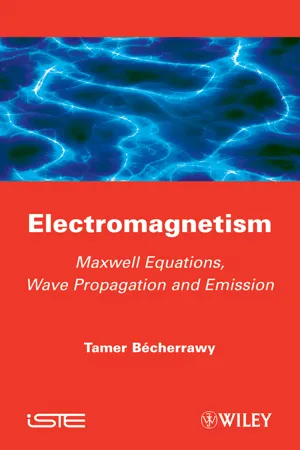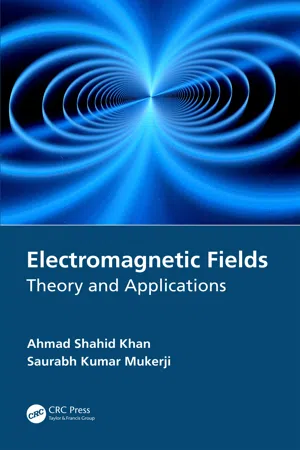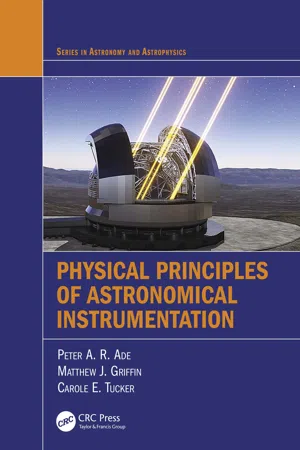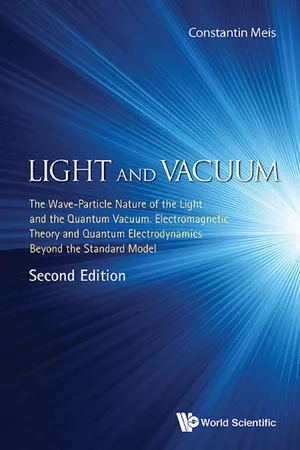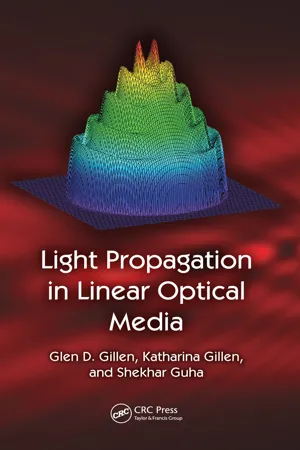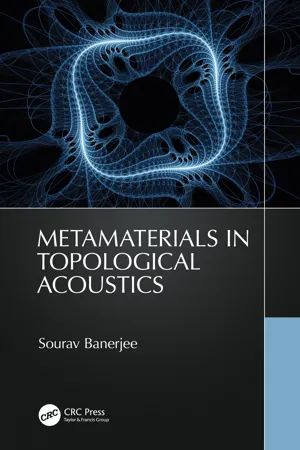Physics
Electromagnetic Waves
Electromagnetic waves are a form of energy that propagate through space, consisting of oscillating electric and magnetic fields. They can travel through a vacuum and do not require a medium for transmission. Electromagnetic waves include a wide range of frequencies, from radio waves to gamma rays, and are fundamental to various phenomena, including light and wireless communication.
Written by Perlego with AI-assistance
Related key terms
Related key terms
1 of 4
Related key terms
1 of 3
11 Key excerpts on "Electromagnetic Waves"
- Tamer Bécherrawy(Author)
- 2013(Publication Date)
- Wiley-ISTE(Publisher)
Chapter 6Electromagnetic WavesA remarkable property of Maxwell’s equations (that was not possible to foresee before the formulation of the electromagnetic theory) is that they have solutions representing Electromagnetic Waves propagating at the speed of light in matter and in vacuum. The existence of these waves was experimentally confirmed, in 1890 by Hertz, who succeeded in producing them and verifying that they have the same propagation, interference, diffraction and polarization properties as light waves. Thus, Maxwell theory has enabled us to understand the nature of light as Electromagnetic Waves with very short wavelengths. Actually, we can produce and detect Electromagnetic Waves of frequencies varying between 10−2 Hz and 1032 Hz, that is, of wavelengths varying between 1010 m and 10−24 m. They play a very important part in nearly all branches of physics and have a considerable impact on economic, social, political and intellectual life. In this chapter, we recall the principal results of the electromagnetic theory, namely Maxwell’s equations. We discuss their wave solution and some applications of Electromagnetic Waves.6.1. Principal results of the electromagnetic theory
The basic concepts of the electromagnetic theory are the electric field E and the magnetic induction field B (also called magnetic field for short) defined by their action on a charge q of velocity v[6.1]In the presence of dielectrics, we also have to introduce the electric displacement (also called electric induction ) D = εo E + P where εo = 8.8541878 x10−12 A2 s4 /kg.m3is the electric permittivity of vacuum and P is the density of polarization (or simply polarization ), i.e. the electric dipole moment of the dielectric per unit volume. In the presence of magnetic materials, we also have to introduce the magnetic field strength (also called magnetic intensity ) H = B/µo - M where µo = µo = 4π x 10−7 kg.m/A2 s2 is the magnetic permeability of vacuum and M is the intensity of magnetization (or simply magnetization- eBook - ePub
Fiber-Based Optical Resonators
Cavity QED, Resonator Design and Technological Applications
- Deepak Pandey(Author)
- 2024(Publication Date)
- De Gruyter(Publisher)
This equation highlights that Electromagnetic Waves travel at the speed of light. The electromagnetic spectrum encompasses a wide range of frequencies and wavelengths, including radio waves, microwaves, infrared waves, visible light, ultraviolet waves, X-rays, and Gamma rays. Each segment of the spectrum corresponds to a different range of frequencies and wavelengths, with visible light being the portion that can be detected by the human eye. As shown in Figure 1.4, the electric field vector E and magnetic field vector B are orthogonal to the wave propagation direction and their amplitudes sinusoidally vary in space and time. This description of EM-wave directly arises from the four fundamental laws of electromagnetism. They describe a deeper connection between the following four basic quantities of electromagnetism [ 3 ]: Displacement vector inside a medium D = ϵ 0 E + P Magnetization vector B = μ 0 (H + M) Charge density ρ Current density J = σ E where P and M are defined as the polarizability and the magnetization and are related to electric and magnetic fields via electric (χ e) and magnetic susceptibility (χ m), respectively. (1.4) P = ϵ 0 χ e E ; M = χ m H Note that with equation (1.4), Displacement and magnetization vectors can also be written in terms of vacuum and relative permittivity and permeability,. respectively, (1.5) D = ϵ 0 (1 + χ e) E = ϵ 0 ϵ r E (1.6) B = μ 0 (1 + χ m) H = μ 0 μ r E where ϵ r = 1 + χ e is the relative permittivity and μ r = 1 + χ m is the relative permeability. Figure 1.4 Electromagnetic wave propagation in a vacuum can be considered as oscillating electric and magnetic fields with a given amplitude in two orthogonal axes and perpendicular to the propagation axis. Maxwell’s equation establishes relations between four quantities D, B, ρ and J - eBook - ePub
- I. S. Grant, W. R. Phillips(Authors)
- 2013(Publication Date)
- Wiley(Publisher)
CHAPTER 11
Electromagnetic Waves
We have already outlined in section 10.4 how a spark discharge can produce changing electric and magnetic fields that propagate outwards from the changing charge and current distributions in the spark. Any charge distribution which changes with time, or any varying current, can give rise to a radiated electromagnetic field. However it is only when the changes are rapid that the radiated fields are large enough to carry away an appreciable fraction of the power dissipated in the system. In practice radiated fields associated with varying currents are usually unimportant unless the variations contain frequencies higher than 100 kHz. This is about the lowest frequency used for commercial transmission of radio waves.In this chapter we will consider some general properties of Electromagnetic Waves propagating in free space or in homogeneous isotropic media. We will also consider what happens to simple waves at a plane boundary between two media. The electromagnetic field will be treated classically. This means that we will assume the energy in the waves to be distributed continuously throughout the space occupied by them, and the energy to depend in some way on the macroscopic fields E, D, B and H. The same approach was adopted in the discussion of the energies in static electric and magnetic fields. The media in which the waves are travelling will also be treated classically, as if they were continuous, and will be characterized by macroscopic quantities such as relative permittivity ε , relative permeability μ , and electrical conductivity σ . These quantities vary with frequency, although the electrical conductivity of almost all substances is effectively constant for most frequencies that we will consider. The interpretation of the parameters ε , μ and σ throws much light on the microscopic description of matter, but these problems will rarely be mentioned in this chapter. The classical theory provides a good description of most electromagnetic phenomena for frequencies below about 1011 - eBook - ePub
- John D. Cutnell, Kenneth W. Johnson, David Young, Shane Stadler(Authors)
- 2018(Publication Date)
- Wiley(Publisher)
CHAPTER 24Electromagnetic WavesEach of the colors on the sails of these boats corresponds to a different wavelength in the visible region of the spectrum of Electromagnetic Waves. As we will see in this chapter, however, the visible wavelengths comprise only a small part of the total electromagnetic spectrum.LEARNING OBJECTIVES
After reading this module, you should be able to…- 24.1 Describe the nature of Electromagnetic Waves.
- 24.2 Calculate speed, frequency, and wavelength for Electromagnetic Waves.
- 24.3 Relate the speed of light to electromagnetic quantities.
- 24.4 Calculate energy, power, and intensity for Electromagnetic Waves.
- 24.5 Solve problems involving the Doppler effect for Electromagnetic Waves.
- 24.6 Solve polarization problems using Malus' law.
24.1 The Nature of Electromagnetic Waves
In Section 13.3 we saw that energy is transported to us from the sun via a class of waves known as Electromagnetic Waves. This class includes the familiar visible, ultraviolet, and infrared waves. In Sections 18.6 , 21.1 , and 21.2 we studied the concepts of electric and magnetic fields. It was the great Scottish physicist James Clerk Maxwell (1831–1879) who showed that these two fields fluctuating together can form a propagating electromagnetic wave . We will now bring together our knowledge of electric and magnetic fields in order to understand this important type of wave.Animated Figure 24.1 illustrates one way to create an electromagnetic wave. The setup consists of two straight metal wires that are connected to the terminals of an ac generator and serve as an antenna. The potential difference between the terminals changes sinusoidally with time t and has a period T. Part a shows the instantt = 0 s, when there is no charge at the ends of either wire. Since there is no charge, there is no electric field at the point P just to the right of the antenna. As time passes, the top wire becomes positively charged and the bottom wire negatively charged. One-quarter of a cycle later(, the charges have attained their maximum values, as part b of the drawing indicates. The corresponding electric fieldt =)1 4TE →at point P is represented by the red arrow and has increased to its maximum strength in the downward direction.* Part b - eBook - ePub
Electromagnetism
Maxwell Equations, Wave Propagation and Emission
- Tamer Becherrawy(Author)
- 2013(Publication Date)
- Wiley-ISTE(Publisher)
10.10. Electromagnetic spectrumAn electromagnetic wave carries energy; thus, it cannot be emitted by charges at rest or in uniform motion: only accelerated charges (or variable currents) may emit them. If the current is a simple harmonic function of time, the emitted wave is simple harmonic of equal frequency. The emitter of a wavelength λ is always a system whose dimensions are comparable to λ. For instance, waves of wavelengths roughly more than 1 mm are emitted by macroscopic systems (electronic or electric).While propagating, an electromagnetic wave is subject to the various effects due to the propagation medium and eventual obstacles. The most important effects are the decrease of intensity with the travelled distance like 1/r 2 (in the case of a spherical wave), reflection on surfaces of large dimensions compared to the wavelength, diffraction by apertures and obstacles of dimensions comparable to λ, absorption by the medium, etc.The most important applications of Electromagnetic Waves are in the domain of telecommunications. Information (sound, image, etc.) may be transmitted by modulated waves , that is, of amplitude, frequency or phase that vary according to the information. Modulation is realized by using an input transducer , which transforms the information into an electric signal. Microphones and photoelectric cells are examples of input transducers. In the receiver, an output transducer transforms the electrical signal of the modulated wave into a non-electrical signal. A loudspeaker and a liquid crystal screen are examples of output transducers. The extracted signal reproduces the original one with some deformation depending on the quality of the system.The following is a classification of Electromagnetic Waves according to their frequency (or their wavelength λ = c / ) and some of their principal uses.1) Waves of industrial frequencies (30 Hz < < 3 kHz and 105 m < λ < 107 - eBook - ePub
Electromagnetic Fields
Theory and Applications
- Ahmad Shahid Khan, Saurabh Kumar Mukerji(Authors)
- 2020(Publication Date)
- CRC Press(Publisher)
16 Electromagnetic Waves16.1 Introduction
Electromagnetic Waves can be conceived in terms of electric and magnetic field vectors, which obey some mathematical relations referred to as wave equations . These equations can be obtained by manipulating Maxwell’s equations described earlier. These waves can be divided into two broad categories, referred to as unguided and guided waves. An unguided wave is one that travels through space after emerging from an antenna. In this mode, the energy radiated by an antenna adopts its course in accordance with the characteristics of both the media and the antenna. In a guided wave, the energy is fed to and travels through a transmitting structure. These structures may include wire pair lines, coaxial cables, conducting and dielectric waveguides, planar lines, and optical fibers. Some of these structures are discussed in Chapter 18 .The unguided waves can further be categorized as plane and non-plane waves. The plane wave in itself can be uniform or non-uniform. The uniform plane wave is the key player in almost all cases wherein communication is to be established through unguided waves. Depending on the mode of propagation, the unguided waves can also be classified as ground, space, and sky waves. The antennas are discussed in Chapter 20 .Whether guided or unguided a wave may come across different types of environments and hindrances with varied geometry and media parameters. In view of the nature, a wave may get reflected, refracted, diffracted, or absorbed. Some of the aspects of unguided waves, particularly those belonging to uniform plane waves, need careful consideration and thorough analysis. This chapter is devoted to the uniform plane waves traveling through the lossless and lossy media whereas Chapter 17 - eBook - ePub
- Bryan Milner(Author)
- 2019(Publication Date)
- Routledge(Publisher)
electromagnetic spectrum.5 Add all these other types of waves to your diagram of the electromagnetic spectrum.■ How fast do Electromagnetic Waves travel?All the different kinds of Electromagnetic Waves travel at the same speed through space. So the waves with the shortest wavelength also have the highest frequency.6 Add the information about wavelength and frequency to your diagram.7 Copy and complete the following sentences.Radio waves have the ____________ wavelength and the ____________ frequency. Gamma rays have the ____________ wavelength and the ____________ frequency.All Electromagnetic Waves are transverse waves. [See page 118 if you can’t remember what this means.]In space all Electromagnetic Waves travel at the same speed.This speed is 300 million metres per second. Electromagnetic Waves are also called electromagnetic radiation.What you need to remember [Copy a n d complete using the key words]Waves beyond the ends of the rainbowThe table shows all the different kinds of waves in the ____________ spectrum. All types of electromagnetic radiation travel through space at exactly the same ____________. All Electromagnetic Waves are ____________ waves.Waves and radiation 8 What happens when Electromagnetic Waves hit things?There are many different types of Electromagnetic Waves.1 Write down the names of seven different types of Electromagnetic Waves.2 Write down two things that are the same about all the types of Electromagnetic Waves.REMEMBER All these types of Electromagnetic Waves are transverse waves that travel at the same speed in space.All Electromagnetic Waves do not need a substance to travel through. So they can travel easily through empty space (a vacuum). - Peter A. R. Ade, Matthew J. Griffin, Carole E. Tucker(Authors)
- 2021(Publication Date)
- CRC Press(Publisher)
3 Interaction of Electromagnetic Radiation with Matter
In this chapter, we review some of the most important processes by which electromagnetic radiation interacts with matter, with particular emphasis on the detection of the radiation and on the effects of the Earth’s atmosphere on the incoming radiation from astronomical sources. The implications for astronomical observations in different parts of the spectrum will be considered in later chapters. The interaction between the radiation and the medium in which it propagates can include absorption, scattering, refraction, and reflection. In the case of a detector, we are mainly interested in absorption, with the additional requirement that the absorbed energy be readily measurable in some way. In general, EM radiation interacts with matter by transferring energy to charged particles (almost always electrons, except at γ-ray energies), in a way that depends strongly on the photon energy (frequency) of the radiation and on the nature and conditions of the medium.3.1 Radio Wavelengths
( λ > ~ 1 m m )If an electron in the material is bound to an atom, it can only gain energy in amounts equal to or greater than the difference between its energy and that of the next highest quantum state. At radio wavelengths, the photon energy is too small to generate new charge carriers in any material. The radiation can therefore only interact if there are free carriers already in the absorbing material, so it must be a conductor, such as a metal, an electrolyte, or a plasma. Radio waves can propagate through significant thicknesses of non-conducting media such as air and concrete but are strongly affected by metal structures.In the radio region, it is more useful to regard the incident radiation not as a stream of photons, but as a wave – a travelling oscillation of the electric and magnetic fields E and B . These oscillating electric and magnetic fields can influence the motion of free charge carriers. In a metal, the electrons are not bound to the lattice atoms and form a dense “free electron gas”. A radio wave incident on a metal will therefore induce oscillating electric currents, as shown in Figure 3.1- eBook - ePub
Light And Vacuum: The Wave-particle Nature Of The Light And The Quantum Vacuum. Electromagnetic Theory And Quantum Electrodynamics Beyond The Standard Model (Second Edition)
The Wave–Particle Nature of the Light and the Quantum Vacuum. Electromagnetic Theory and Quantum Electrodynamics Beyond the Standard Model
- Constantin Meis(Author)
- 2017(Publication Date)
- WSPC(Publisher)
c. denoting the complex conjugate part.From (3.2.12 ), (3.2.17 ), (3.2.21 ) and (3.2.22 ), we deduce the Helmholtz equation for each component of the electric fieldIn other words, in the classical electromagnetic theory, the electric and magnetic fields oscillate perpendicularly along the propagation axis k with an angular frequency ω at the speed c/n.This is called simply a plane wave solution. In this representation the wave vector in vacuum (n = 1) has the simple expressionwhere λ is the wavelength, representing the spatial distance of a complete oscillation of the electric and magnetic field vectors over a period T and , the unit vector along the propagation axis.For a given fixed value of the angular frequency ω, and the wave-length λ, the wave is called monochromatic (single color) and we will use the notations and for the corresponding electric and magnetic fields, which, according to the above considerations obey the same propagation equationwhere is either or .More generally an electromagnetic wave is called Transverse Electro-Magnetic (TEM) when both and - eBook - ePub
- Glen D. Gillen, Katharina Gillen, Shekhar Guha(Authors)
- 2017(Publication Date)
- CRC Press(Publisher)
2 Electromagnetic Waves in Linear MediaIn this chapter we present mathematical models describing the vector electric and magnetic fields for light propagating within a linear medium. Mathematical models presented cover:To simplify the mathematics for this chapter, we place the following restrictions on the propagation of the light through the medium:- General forms for Maxwell's equations and the wave equation
- Maxwell's Equations for source- free media
- Maxwell's equations for vacuum
- Polarized light fields
- the volume through which the light is propagating is composed of only a single medium
- the medium’s electric permittivity, ∈, and magnetic permeability, µ , are both constants
- there are no boundary conditions for the volume, nor diffractive or spatially limiting elements within the volume
2.1 Maxwell's Equations in Linear Media
As discussed in Sections 1.2–1.4, when Electromagnetic Waves propagate through a medium other than a vacuum the electrodynamic properties of the medium must be taken into consideration. Here, we will assume that the medium can have any one, two, or all three of the following properties:- the electric field of the EM wave, Ẽ , induces a dipole moment per unit volume, P ˜, within the medium,
- the magnetic field of the EM wave, induces a magnetic moment per unit volume,H ,˜M ˜, within the medium, or
- the medium can have free charges per unit volume, or a free charge density, ρ .
The response of the medium to the incident electromagnetic fields can either be a linear response or a nonlinear response. In general, the magnitude of the induced polarization in the medium, P - eBook - ePub
- Sourav Banerjee(Author)
- 2023(Publication Date)
- CRC Press(Publisher)
Understanding of Electromagnetic Waves is the key to the study of photonics. In this chapter electromagnetic wave equation is derived from the fundamentals. The electromagnetic wave equation is solved from the fundamentals, comparing the wave equations for acoustics and Electromagnetic Waves simultaneously. Phonons in acoustics and elastodynamics are equivalent to the photons in electrodynamics. The comparison is presented for equivalent application of phononics in acoustic metamaterials in a later chapter. Understanding of Electromagnetic Waves and its equivalency helps understand the fundamentals of quantum mechanics discussed in this book.REFERENCES
- Forbes, N ., Mahon, B., Faraday, Maxwell, and the Electromagnetic Field: How Two Men Revolutionized Physics . 2014, Amherst, New York: Prometheus Book.
- Fitzpatrick, R ., Maxwell’s Equations and the Principles of Electromagnetism . 2008, Jones & Bartlett Learning. 2008-01-22: https://www.jblearning.com/ .
- Gonzalez, G ., Advanced Electromagnetic Wave Propagation Methods . 2021, Boca Raton, FL: CRC Press.
- Feynman, R.P ., Quantum Electrodynamics . 1971, Boca Raton, FL: CRC Press.
- Greiner, W ., Schramm, S., Stein, E., Bromley, D.A., Quantum Chromodynamics
Index pages curate the most relevant extracts from our library of academic textbooks. They’ve been created using an in-house natural language model (NLM), each adding context and meaning to key research topics.
Explore more topic indexes
Explore more topic indexes
1 of 6
Explore more topic indexes
1 of 4

